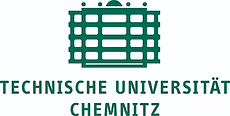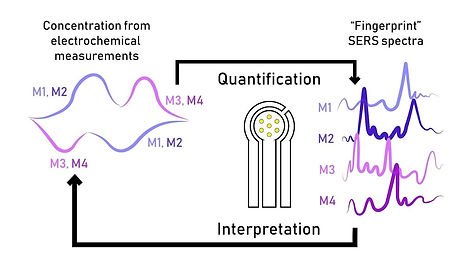
Ultrasensitive detection using the combination of SERS and Electrochemistry
GRANT № 21-53-12045
Bi-lateral Russian-German joint project (RFBR-DFG)
Dual sensing as a novel approach for highly specific chemical analysis in pesticide detection

German side: Prof. Dr. Olfa Kanoun
olfa.kanoun@etit.tu-chemnitz.de
Technische Universität Chemnitz
Str. der Nationen 62, 09111 Chemnitz, Germany

Russian side: Prof. Dr. Evgeniya Sheremet
Tomsk Polytechnic University
Lenin Ave 30, Tomsk, 634050, Russia
Objective
This project aims to study a synergistic combination of optical and electrochemical methods for the ultrasensitive label-free detection of analytes in complex mixtures. The work has an impact on the environment and health as pesticides are among such challenging contaminants found in water, food, and soil since they are exponentially accumulating in the environment posing a serious risk to human health.
Background
The gold standard approaches of analytical chemistry detection are costly and laborious. The electrochemical approaches, such as impedance spectroscopy and voltammetric methods, are inexpensive and quantitative, widely used in analytical chemistry, but they typically have poor selectivity. Surface-enhanced Raman spectroscopy (SERS) is highly sensitive and detects chemical "fingerprints" of molecules, but it faces critical challenges when it comes to making quantitative analyses.
Idea
Combining two approaches based on independent physical principles - electrochemical methods such as impedance spectroscopy and voltammetry with SERS - on a single SERS electrode surface creates the possibility to obtain more complete and quantifiable information about the complex analyte.
Challages
However, the independence of the two methods is deceptive. In reality, electrical potential affects the surface properties, ion concentration and charge transfer between the analyte and the electrode directly affecting SERS enhancement. The photo-induced effects such as photocatalytic reactions on plasmonic surfaces can create new products offering new possibilities to obtain additional information on the complex mixtures by analyzing these products.
Impact
Here we intend to investigate the dual-sensing approach and the fundamental questions it opens. The fundamental insights gained from investigating the combination of both methods in a synergistic manner, will in the future allow creating novel and cost-effective portable, highly specific and ultrasensitive sensor systems.
NEWS

Figure: Concept idea of the dual-sensing approach combining electrochemical methods and surface-enhanced Raman spectroscopy in one single device.
TPU project was supported by the RFBR and DFG
The Russian Foundation for Basic Research (RFBR), together with the German Research Foundation (DFG) summed up the results of competitions for the best projects of fundamental scientific research published on the RFBR site
The competition of the Russian Foundation for Basic Research and the German Research Foundation was won by the lead of Professor of the Tomsk Polytechnic University Evgeniya Sheremet and Professor of the Chemnitz University of Technology Olfa Kanoun "Dual sensing as a novel approach for highly specific chemical analysis in pesticide detection" (№ 21-53-12045).
A total of 200 applications were submitted for the competition. 46 projects received support.
"The aim of this German-Russian project is to develop low-cost portable sensors for pesticide detection that are ultrasensitive and highly selective"
Throughout the project duration, SERS electrodes will be fabricated and thoroughly characterized. Reduced GO (rGO) functionalized by plasmonic nanoparticles will be the basis for building the SERS electrode.
Carbon-based electrodes are very common in electrochemical measurements due to their high chemical stability, while laser-reduced graphene oxide offers an additional degree of control over the surface roughness and surface energy. Functionalization by plasmonic nanoparticles will provide the SERS enhancement that can be optimized by changing their size and density.
The rGO-based electrodes will be fabricated by laser patterning. The proper conditions (laser energy, focusing optics, and power density) for electrode writing on the GO will be optimized. Laser-induced and electrochemical deposition of Ag and Au NPs from AgNO3 and HAuCl solutions will be also carried out to selectively functionalize the working electrodes. The deposition parameters will be optimized towards achieving the highest amplification possible of the electrical/optical signal. Physical, optical, and electrical characterization to investigate the structure, surface morphology, conductivity properties of the patterned layer will be performed by the means of sheet resistance, Raman spectroscopy, and atomic force microscopy (AFM) including current sensing AFM and Kelvin probe force microscopy, scanning electron microscopy (SEM) and X-ray photoelectron spectroscopy (XPS).
December 24, 2021
TPU scientists in the development of Graphene-glass Electronics
Throughout the first year of the project, we discovered how to integrate graphene and silver nanostructures into glass using laser processing to make electrically conductive multifunctional devices. "Combining an inexpensive and scalable method such as laser processing (laser-induced backward transfer - LIBT) while providing functionality and electrical conductivity to glass is a significant breakthrough not only for material sciences but technological applications from making windows as solar cells and displays to making glassware “smart” with functional sensors and electronics", Raul D. Rodriguez Contreras, Professor of the TPU Research School of Chemistry and Applied Biomedical Sciences, says.
This discovery goes beyond conventional transparent conductors on glass, since our technology provides functionalization with silver nanostructures, allowing dual plasmonic and electrochemical sensing with a detection limit down to the nanomolar range.
The project is supported by the Russian Foundation for Basic Research № 21-53-12045.

Figure: (a) rGO-LIBT glass. (b) AgNPs-PVP solution onto rGO-LIBT covering all the glass area. (c) Sample after laser irradiation. Two sections were irradiated, one section with rGO-LIBT and another section without rGO-LIBT. It is observed that in the area with rGO-LIBT there is an integration of Ag NPs unlike the area without graphene composite, where the integration of Ag NPs is not evident. (d) Samples after sonication in distilled water confirming the integration of Ag NPs onto rGO-LIBT.
